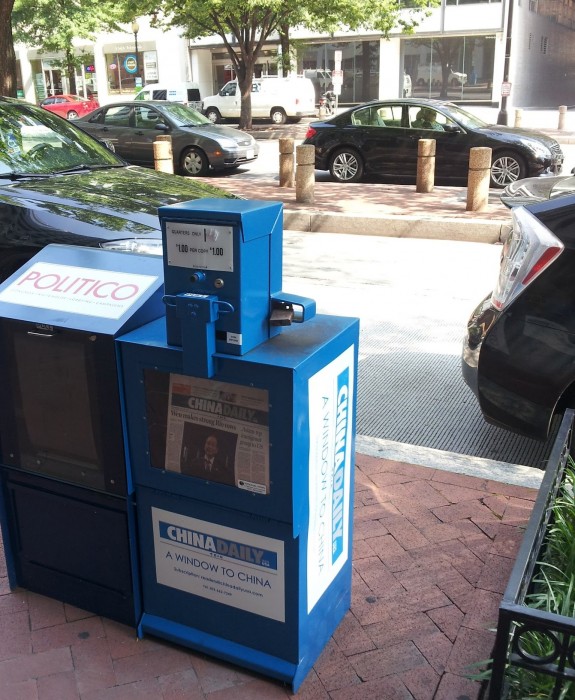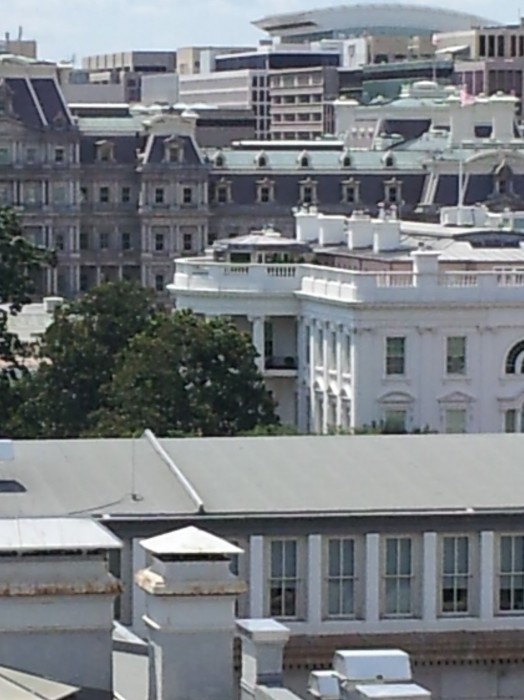It has been a long time since I walked the streets of the United States capital. Like Cambridge, much remains unchanged, but there are some telling alterations. I thought it was a sign of the times that on K street, the home of the political lobbying industry, you can now buy a copy of the China Daily. China’s leading English language newspaper will be familiar to many foreigners who stay at hotels in China. It describes itself as a “window on China”, though the glass is cleaned, etched and sometimes broken by the Chinese Communist Party. By including more criticism of social problems and even of the government than normal official publications the China Daily is quite clever propaganda. Reading it gives the illusion that you just might be getting a more accurate and uncensored glimpse of modern China. It’s very professionally put together and probably essential to all those American politicians who mix fear and curiosity about the economy that is fast catching up with them.
Mixed architecture
The historic core of DC is protected, though the zoning laws seem relatively relaxed compared with Paris or even London. The photograph below, taken from the wonderful roof bar at the W Hotel, shows the White House in the middle ground. Behind it is the French Second Empire style architecture of the Eisenhower Executive Office Building, built in the late nineteenth century and now in effect an extension of the White House. It’s striking that at that time (1871) a prestigious American building would be constructed in the style of Parisian architecture (just at the time when France was decisively losing European dominance to Prussia). Note the modern and rather ugly buildings in the background.
Various architecture, central Washington DC
In front of the White House, in the foreground, is the top of the US Treasury Department. It is more than symbolic that the government building closest to the executive is the Treasury, a massive neoclassical building that still houses the taxing and spending functions. The young republic was first and foremost about fiscal policy. A number of writers have noted the parallel for modern Europe with the actions of Alexander Hamilton, the first Treasury Secretary. Hamilton forged a new federal debt policy that rescued the debt-broken weaker states by merging them, financially, with the stronger. In other words, a fiscal union that was justified by political union. You can see the example it sets for those who would like to see the emergence of a United States of Europe. Or those who simply don’t want the Euro to collapse and bring down the European Union with it.
By contrast the State Department is now located in Foggy Bottom, several blocks away from the White House, even though the Secretary of State is first in line in the cabinet after the President and Vice President. Thomas Jefferson was the first holder of that post and the early years of the USA were marked by competing visions of the role of the state put forward by Hamilton and Jefferson (plus James Madison). Jeffersonian hostility to federal power was the reason why the US had no permanent central bank till 1913. An earlier central bank, the First Bank of the United States, was shut down after its initial 20 year charter expired in 1811. A Second Bank also had only a temporary life (1817-36). Even today the fault lines of that debate are visible in the controversy about the role and duties of the Fed, with many Republicans arguing it should be confined narrowly to the control of inflation. There is a reasonably influential fringe that argues for the denationalisation of the currency in favour of every bank having the right to offer its own, as was the case for much of the nineteenth century. The instability of that system was the main reason why the Fed was created but history is not always remembered.
War memorials
Washington DC has lots of war memorials, including the DC memorial and those for the Second World War, the Korean War and the Vietnam War. This last is, in my experience, a particularly sad place. The picture below includes MFin alumna Elona Cela for scale. Behind her are some of the 58,272 names etched in a simple, elegant 150m long wall.
Nowhere that Elona is present can be entirely lacking in joy but the Vietnam Veterans Memorial is very sombre and moving. I first visited in the late 1980s, not long after it was completed in 1982 and only about a decade after the war ended in 1975 (the US pulled out in 1973). There were flowers all over the place and many grieving visitors. Today there are fewer, and the crowds of visitors are larger, but it’s still affecting.
The Memorial was very controversial when first created. Many disliked its plain design, seeing in this an implicit rebuke or criticism of the war. The Memorial is entirely a record of the sacrifice of the combatants, not any commmentary on the war but you can imagine how sensitive people were. Second, the architect who won the (blind) design contest was a Chinese American called Maya Lin, which further upset some people. But now the Memorial is respected and accepted and the design is widely seen as a success.
It is no disrespect to the Americans who died and were wounded in the Vietnam War to note that if the memorial were to carry the names of the Vietnamese who died it would be 5.2km (3.2 miles) long, on the median estimate of 2m deaths. It is therefore quite heartening that the US and Vietnam are now allies. This reflects the realpolitik that Vietnam wants US involvement in the South China Sea to balance Chinese influence. But it also shows the belated understanding on both sides of their former adversary’s point of view. The US was in Vietnam to stop the spread of Communism from China. Chinese and United Nations troops had been on opposite sides of the Korean War in 1950-53. The American government feared Chinese influence in the Vietnamese Communist Party. But in the gripping documentary The Fog of War, former Secretary of Defense Robert McNamara tells of a meeting in Hanoi years after the end of the war. A senior Vietnamese politician asks him, amazed, did you not realise that we have been fighting the Chinese for a thousand years? We could never be agents of Chinese expansion. When Vietnam invaded Cambodia in 1978 to evict the genocidal Khmer Rouge regime, China (in alliance with the US and the UK) strongly criticized the action and then invaded Vietnam. While Vietnam’s motives were mainly self-interested, it nonetheless destroyed an extraordinarily brutal tyranny and for that was condemned by the UN.
The controversy over a memorial for soldiers who fought in a war that is not seen as America’s finest hour (to put it mildly) has a modern resonance in the UK. The 55,573 dead combatants of the British Bomber Command in the second world war have had no memorial, unlike every other arm of the British armed forces. Nor did the survivors receive a dedicated campaign medal, unlike Fighter Command. Very belatedly, a permanent memorial was unveiled by the Queen on 28 June, 2012. Bomber Command was treated differently from Fighter Command because of shame over the massive destruction of German cities in the last three years of the war. By contrast, Fighter Command is celebrated for the Battle of Britain, which saw a small number of pilots fight off the Luftwaffe, thereby preventing the invasion of Britain. While the Germans “started it” by bombing London and other British cities in the Blitz of 1940-41 (which my mother and her family lived through), the scale of the Allied response (the US joined the UK in systematic destruction of German cities) can be gauged by one comparative statistic. The worst single raid in terms of numbers dead in the UK was on London in May 1941, when 1,436 died. Operation Gomorrah, the week-long joint RAF-USAF raid on Hamburg in July 1943 killed 42,000 people, most of them civilians. Estimates of the dead in the better known Dresden raid of February 1945 range higher but the best guess is somewhat lower than for Hamburg. In the region of 100,000 died in the atomic bomb attack on Hiroshima but even more died in the conventional raids on Tokyo. (The weapons developed in the cold war would increase these results by two orders of magnitude). Historians now mostly agree that the raids on Germany did relatively little to advance the war effort, just as Hitler’s diversion of the Luftwaffe to attack British cities was a strategic mistake.
Architecturally the Bomber Command memorial is praised by the Daily Telegraph and criticised by The Guardian. Perhaps it’s a coincidence that the Telegraph is a right wing paper and the Guardian left wing. There are many who condemn the memorial for celebrating the death of German civilians but that is wrong. It is, like the Vietnam Memorial, to commemorate those who died in combat for their country, even if their political leaders made terrible mistakes.





James Barton
“This reflects the realpolitik that China wants US involvement in the South China Sea to balance Chinese influence.”
Vietnam?
Simon Taylor
Thanks James, you’re quite right. I’ve now corrected it.